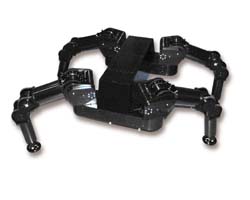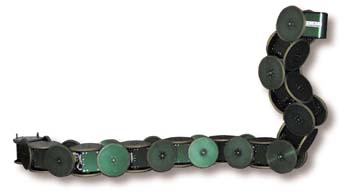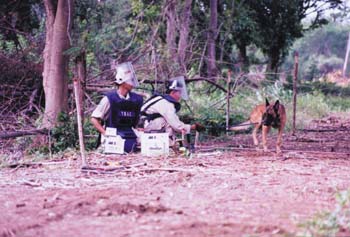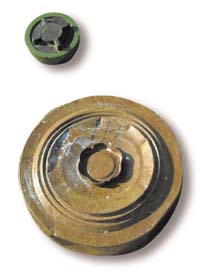Technology for the Front Lines
Back to Contents of Issue: December 2002
|
|
|
|
by Mayumi Saito |
|
 LANDMINES KILL SOMEONE EVERY 20 minutes, according to the International Committee of the Red Cross and the United Nations. That's nearly 26,000 people a year. The deadly surprises are scattered over 60 countries, but a few countries -- Angola, Afghanistan, Iraq and Cambodia-- bear much of the burden: Their landscapes are dotted with tens of millions of mines. LANDMINES KILL SOMEONE EVERY 20 minutes, according to the International Committee of the Red Cross and the United Nations. That's nearly 26,000 people a year. The deadly surprises are scattered over 60 countries, but a few countries -- Angola, Afghanistan, Iraq and Cambodia-- bear much of the burden: Their landscapes are dotted with tens of millions of mines.The efforts of the international community to eliminate mines are discouraging to say the least. Each year, about 100,000 landmines are disposed of, while two million more are planted in the ground. Even if no new mines were deployed, it would take centuries to rid the world of its 65-75 million mines using current methods of manual detection and detonation. That's where technology comes in. Robotic scientists and engineers from Japan are busy developing cutting-edge mine detectors. They are cooperating with the government, nongovernmental organizations (NGOs) and big corporations, and the results of their efforts are inflating the hopes of those on the front lines of the fight against landmines. "Japan has been enthusiastic about mine-awareness education and has contributed a lot of money through nongovernmental organizations," says Katsuhisa Furuta, who is doing mine technology research at Tokyo Denki University. "Nonetheless, we don't have much local presence -- other countries' organizations make up the actual work force. We would like to make our contribution more through our technology." The way mines are detected today involves significant physical risk. Conventional metal detectors are used for most de-mining, but they are notoriously slow and inaccurate because they respond to all metal objects and don't detect most new landmines, which come covered in plastic. The teams also use dogs to detect gunpowder. At best, it's an imperfect science. In January, the Education Ministry, which also handles technology issues, formed a study group to look into technology for detecting and removing antipersonnel landmines as part of Japan's support for Afghanistan's recovery process. Afghanistan's landscape is littered with mines from the former Soviet Union's invasion in 1979, and, more recently, from the war between the Northern Alliance and the Taliban after the September 11 attacks in the US last year. The ministry set up a three-year project to develop mine detection and removal technologies and a five-year project to put them to use in Afghanistan. Collaborating with the Japan Science and Technology Corp., the Foreign Ministry and the Defense Agency, the ministry solicited studies and chose 12 for subsidies in October. Some of the most exciting projects are introduced here. Titan IX & ACM I-III Tokyo Institute of Technology's Shigeo Hirose was one of the first Japanese scientists to tackle the mine-removal issue. He's been at it since 1996. His team has developed Titan IX, a 1-meter-long, 90-centimeter-wide quadruped robot, which can both detect and remove mines. Similar to Comet III, this walking robot's cerebral center remains relatively intact even if one leg gets damaged by a mine. Focused more on mobility than on sensor technology, Titan IX is equipped with a conventional metal detector in each leg and is capable of entering areas people can't. This automatic robot can dig out mines with the "hand" at the leg's end and detonate the mine using an additional remote control system. Another project by Hirose's team is the ACM I-III. These 1.6 meter-long, snake-shaped robots can crawl under the rubble of a city, through the ditches and the grass without putting pressure on buried landmines.  Of course, mine-detecting robots can be pricey and are likely to be way beyond the budgets of most NGOs. That's why Hirose has been trying to develop more affordable and practical detection measures. One of them is to run two buggies in the hilly minefield with a 10-meter-long tether in between that tries to detect metal. To detect plastic mines, he is experimenting with attaching a sensor to conventional prodding devices, which will identify hollow objects that can contain gunpowder.
Of course, mine-detecting robots can be pricey and are likely to be way beyond the budgets of most NGOs. That's why Hirose has been trying to develop more affordable and practical detection measures. One of them is to run two buggies in the hilly minefield with a 10-meter-long tether in between that tries to detect metal. To detect plastic mines, he is experimenting with attaching a sensor to conventional prodding devices, which will identify hollow objects that can contain gunpowder.Comet III One of the more promising projects for fighting landmines is the 4-meter-long, 2.5-meter-wide, 1-meter-high Comet III, developed by Kenzo Nonami's group at the University of Chiba. This insect-like, six-legged robot is equipped with a swinging disk that joins with four others in front. The disk is a highly sensitive metal detector with an electrical circuit that responds to just three or four grams of metal in a plastic landmine buried up to 30cm in the ground. The detector is also combined with underground radar, which radiates two gigahertz of electromagnetic waves and detects the reflection of landmines buried up to 80cm in the ground. Once a mine is detected, a spray gun on the front of the Comet III shoots paint onto the ground to mark the location. The 900-kilogram robot is powered by an engine or by remote control to detect antipersonnel mines, antitank mines and blind shells (shells that contain no charge or do not explode).  The dog nose
The dog noseFuruta of Tokyo Denki University is coordinating different studies that share a goal of developing a "nose" that would discern gunpowder in plastic mines -- a job now performed by dogs. One idea is to use gamma rays to detect the TNT. Another approach is to develop a biosensor with an antibody to TNT that would detect the compound in a buried mine. A third approach being studied by Furuta's team is to use nuclear quadruple resonance, or NQR, which would digitize TNT in a process similar to that used in magnetic resonance images (MRIs) of the human body.  Mine Eye
Mine EyeOne machine in the vanguard of Japanese de-mining efforts has already been deployed overseas. Mine Eye is waiting for action in Thailand. Developed by the nonprofit organization Japan Alliance for Humanitarian De-mining Support (JAHDS,) this machine has a 700-gram sensor that beams electromagnetic waves into the ground and analyzes the reflection. It then displays on a liquid-crystal screen the object's image, its position (including how deep it is in the ground), and its composition. JAHDS was founded in 1998 as a corporate consortium initiated by underground engineering firm GeoSearch and by a request from the UN Mine Action Service. The consortium is coordinated by Secom and has contributed key technology from several of its members: sensors developed by Omron, computer analysis from IBM, monitors from Sharp and technology used for underground searches by GeoSearch. Toyota and Honda have also provided wheels and generators. JAHDS has committed to a 20- to 30-year plan for de-mining the Thailand-Cambodia border, collaborating with the Thailand Mine Action Center and the Chachai Foundation. Their first project is to clear 400,000 square meters around Sdok Kom Thom, a Khmer-styled temple built in 1057. Once the mines are removed, this national sanctuary is expected to lure tourists. JAHDS' Mine Eye was tested in the nearby Aranyaprathet area from March through October. With staff training and coordination scheduled to be done by the end of this year, the device will be at work with sniff dogs and conventional metal detectors from January. "The Mine Eye technology is only a part of the project," insists Hiroshi Tomita, executive director of JAHDS. The organization is carrying out the world's first de-mining project run by an NPO and has had to raise as much as $800,000 to pay for the project. "Recognizing risks and thoroughly planning are crucial to persuade local taxpayers of the project's use." Legal changes Furuta, who has been actively involved in the Education Ministry's screening process, says Japan has long faced a legal obstacle to exporting de-mining technologies. The Export Trading Management Law prohibits the export of arms or affiliated technologies to politically unstable nations. Although mine detectors and removers were exempted from this law in 1997, Japan and the country receiving the technology still had to agree on the exports before they could be sent. Thus, exporting these technologies to a makeshift government in Afghanistan, for example, was still difficult. This law could have undermined the motivation of researchers, Nonami says, because the more sophisticated the machines being developed, the more likely it was that they would face an export ban. But that all changed in August, when the Ministry of Economy, Trade and Industry amended the law to completely separate de-mining devices from arms and enable their unlimited export. While scientists and engineers are making impressive strides in de-mining technology, is Japan doing enough? Patrik Blagden, technology department head of the Geneva International Center for Humanitarian De-mining, told the foreign affairs magazine Gaiko Forum that Japan is being looked to for innovative technology. However, he is concerned with Japan's current support system for de-mining activities, represented by various organizations from the public and private sectors. Lack of a long-term strategy for tackling the landmine problem will diminish Japan's pull on this issue, he says. International opinion against landmines surged in the 1990s as calls were made for a complete ban on their production, stockpiling and use. In 1997, 121 countries and territories, including Japan, signed the Total Ban Treaty on Antipersonnel Mines in Ottawa, Canada. This treaty and then-foreign minister Keizo Obuchi's JPY10 billion subsidy for the Zero (Landmine) Victim Program prompted Japan's recent studies of mine detection and removal technologies. Perhaps a solution to the horrible problem of landmines is in the works, but as we wait, another 20 minutes goes by. @ Mayumi Saito is a regular contributor to J@pan Inc. Her most recent article was Keeping Tabs on the Food Chain in July 2002. |
|
Note: The function "email this page" is currently not supported for this page.





